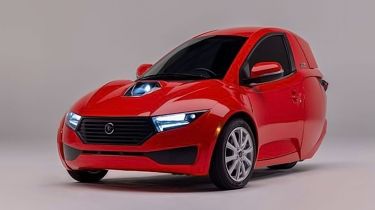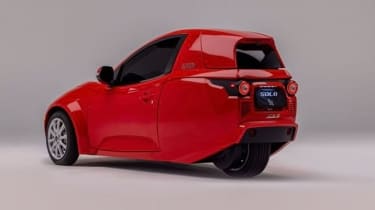ElectraMeccanica Solo: prices and specs for the three-wheeled EV
The ElectraMeccanica Solo was a unique small EV: we give you an overview of what it was and why you can no longer buy one

While most modern electric cars follow a similar format to the combustion vehicles we’ve been used to for decades – hatchbacks, SUVs, a saloon here and there – there’s a separate breed of EVs that do things a little differently, prioritising simplicity, low cost and compact dimensions.
The Solo, from Canadian firm ElectraMeccanica, was one of these: a three-wheeled EV around half a metre shorter than a Kia Picanto (although both longer and wider than a Citroen Ami), with seating for one.
You’d be forgiven for never having seen the Solo before, because it has so far only been sold in North America – although one did run up the hill at the 2022 Goodwood Festival of Speed. The company arrived in 2015 and began selling Solos in 2018, but it hasn’t been easy going; earlier in 2023, ElectraMeccanica issued a recall, buyback and full refund of 429 affected Solos due to a propulsion issue.
A few early cars are unaffected, but it’s likely many Solos will never see the road again. The company has also ended production of the model, with plans to merge with commercial truck firm Tevva, apparently shelving ideas to replace the Solo with a compact four-wheeled EV made in its Arizona factory.
If you're looking for a tiny EV, why not instead check out our list of the best small electric cars on sale now? Our rundown of the cheapest electric cars may also be handy if you're on a budget. Keep reading for more on the ElectraMeccanica Solo.
ElectraMeccanica Solo electric motor, battery, range, charging and performance
Such a compact car needs only a small battery and motor to deliver surprisingly usable performance. While ElectraMeccanica tweaked the car’s specification over time, most Solos make around 54bhp from an electric motor driving the single rear wheel, with a 17.4kWh lithium-ion battery pack supplying the energy.
The company quoted a range of 100 miles by the EPA standards used in the United States, or 125 miles on the European NEDC test, with real-world range likely falling somewhere between those two figures in good conditions. With no fast-charging facility like many modern electric cars, owners would be expected to charge using a conventional plug – an estimated charge time on a 220-volt US circuit is around 2.5 hours from 0-80 per cent, and four hours to 100 per cent. The charging port itself is located behind the rear number plate panel.
While charging isn’t that quick for such a small battery pack, performance is quite reasonable. Again, specifications changed slightly during the car’s few years on sale, but 0-62mph was variously quoted between a brisk 8.0 seconds, and a more modest but still nippy 12.0 seconds – or around two seconds quicker than the Kia Picanto. The Solo also has a top speed of 80-85mph, so despite its size, it’s far from being a Citroen Ami-style urban-only quadricycle.
Styling
The Solo is tiny by the standards of most cars, coming in at 3,103mm long, 1,553mm wide and 1,334mm tall, while it also weighs under 800kg – getting on for twice the weight of a Citroen Ami, but significantly lighter than the majority of modern city cars.
It’s also an odd-looking device, on account of both its compact proportions, and its three-wheeled layout, with a pair at the front and a single rear wheel, similar to a Morgan Super 3 sports car. From the front, and along most of its length, you could almost mistake it for a conventional car – it has a modern and aggressive look and regular doors. But there’s no risk of mixing it up with any other car from the back. Not only does it taper to a narrow tail, but there are no rear windows.
ElectraMeccanica offered a small range of straightforward colour options, including a bright red, white, black, silver and a metallic blue, while interior trim was limited to a uniform black.

Interior and practicality
A one-seat layout like the Solo clearly narrows down its market somewhat, although the company’s rationale was sound: at launch, it stated that more than 80 per cent of commuters in North America cover under 40 miles per day, and mostly do so with no passengers.
The Solo is, however, a fully-enclosed vehicle, with conventional doors and windows to shut out the weather, as well as modern features like air conditioning. There’s also a proper seat rather than a stylised plastic mould like you’d find in a Renault Twizy or Citroen Ami, so in that respect, it could still serve as a functional car for some drivers. The narrow dashboard with its digital instrument display is far from stylish, but along with car-like door panels, it adds to the “conventional car” feel.
With no rear passenger seat, ElectraMeccanica instead designed a luggage area into the Solo’s tail, with a flip-up lid a little like the top box on a touring motorcycle. The company quoted five cubic feet of luggage space, which translates to a surprising 142 litres, more than double that of the Ami, although the waist-high loading lip and small aperture isn’t the last word in accessible space. It’s good enough for delivery drivers though – in California, one Pizza Hut franchisee bought a fleet of Solos to deliver takeaway pizzas.
Equipment and specifications
The Solo came in (quite appropriately) only one trim level, although the company did show off examples of the car with no roof, and one with an enlarged luggage area, which would likely have become options had the Solo stuck around.
Equipment was reasonable for such a small car, and leagues ahead of quadricycles. Air conditioning was standard, as were electric windows and mirrors, a single-DIN stereo (which opened up the possibility for upgrades), an electric handbrake, keyless entry, a heated seat and a reversing camera. What you didn’t get was a driver’s airbag, nor anti-lock brakes (ABS) – a giveaway that this wasn’t a car in the conventional sense, and didn’t have to meet the same safety standards as most vehicles.
ElectraMeccanica Solo prices
At launch in 2018, the Solo started at $15,500, or around £12,000 at the time. By 2022, that price had risen to $18,500, or just under £14,000 – around £11,500 less than the BYD Dolphin which, unlike the Solo, is classed as a proper electric car. The ElectraMeccanica Solo is no longer available to buy, though – there may still be a handful of these electrical oddities around on the used market, but finding one could prove quite difficult.
Most Popular

EV Deal of the Day: budget-friendly Ford Capri for just £234 a month

